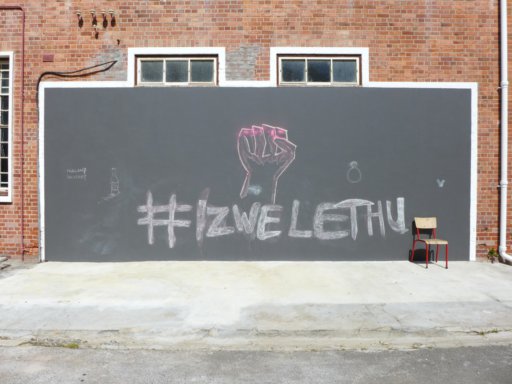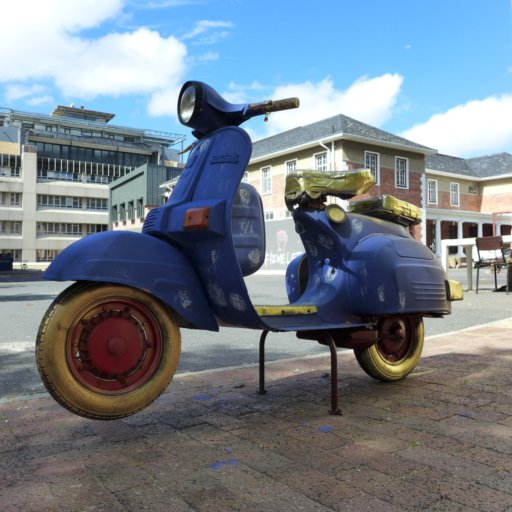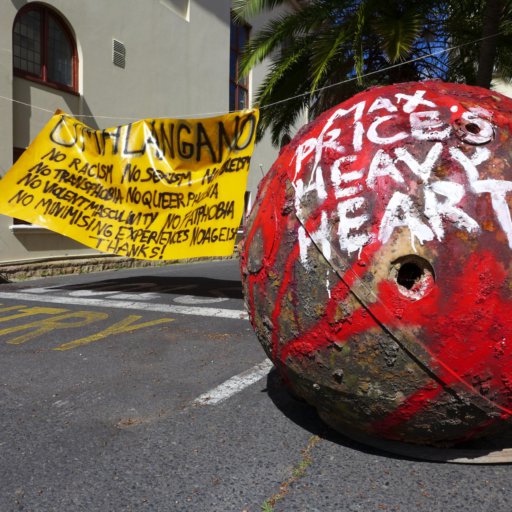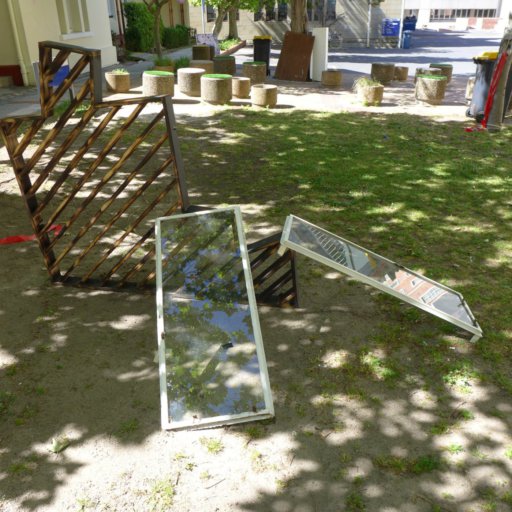The Impoverished Visual Choreography of Refusal
Students allied to the Fallist Movement are currently lightly occupying Hiddingh campus, an outlier property of the University of Cape Town where its art and drama schools have long been quarantined in an eccentric warren of colonial buildings. The acrimony and nihilism that has flourished in tandem with the on-going shutdown is easy enough to follow online. It is also emblematic of wider disagreement and incivility, much of it channelled through online forums. But, being a paid looker, it is the physical markers of this small, some might argue incidental occupation that interest me.

Evidence of the carnivalesque takeover of Hiddingh Campus, staged under the banner Umhlangano, includes slowly deflating party balloons, chalk graffiti and an unoccupied tent. The convivial grass lawns in front of the Michaelis Galleries features a geometric sculpture with burn marks that suggests Sandile Zulu in conversation with Rodan Kane Hart. A blue-and-gold Bajaj Chetak scooter is parked like a barricade on an access road leading to the Little Theatre Workshop, which has a clenched fist drawn on its exterior wall. The Indian-made scooter intrigues, maybe only because it recalls, in form if not idea, the nimble ready-mades of Mexican artists Damián Ortega and Gabriel Orozco.

For every resonant image and allusive object on view, and there are many, there are countless words, a veritable surplus. Some are generous, some thoughtful, some snarky, and some emphatic. In the common area of a men’s toilet inside Hiddingh Hall, a Basquiat-influenced piece of graffiti referencing the painter’s SAMO period trenchantly offers: “Your white walls look ugly without my art”. A chalkboard outside the hall presciently states, “Art Vibes”. A handwritten poster nearby flies a proposal to rename the art school for either Helen Sebidi or Esther Mahlangu – Gerard Sekoto is only offered a building name, while former graduate and lecturer Zwelethu Mthethwa gets no mention. (In a ballot I’d nominate Ernest Mancoba, possibly Tony Gum, whose figurative style clearly commands the attention of some poster-makers.)
There is an optimistic narrative undergirding this occupation, one that aims to address the crude feedback of lived experience in South Africa. It is crystallised in a hand-painted yellow banner suspended across a service road between Hiddingh Library and Betram Place. This declamatory bill of rights written in the negative reads: “No Racism, No Sexism … No Transphobia, No Fatphobia … No Minimising Experiences … Don’t be kak, babes.” The generosity of the latter statement hasn’t fully been honoured, but I may well be misreading some of the drawings and quotations of staff in the exhibition Uyaphi?, on view in an upstairs annex of the Michaelis Galleries.

Stranded in a parking bay near the fluttering-in-the-breeze yellow banner is a large, red-painted polystyrene buoy. Small shells are visible on its pitted surface. The sculptural piece, which has a kind of Mike Kelley vibe (see his Educational Complex Onwards, from 1995-2008), sports a caption in white paint: “Max Price’s Heavy Heart”. Geddit? Brash metaphors and contingent aesthetics are a hallmark of this lethargic seizure – as they have always been of protests, marches and sit-ins elsewhere.
The improvisational aesthetics recall, at least for me, the DIY character of the physical infrastructure and handmade things I saw in 2011 at Zuccotti Park, site of the Occupy Wall Street sleep-in. The insistence on marrying figurative image with typographic message is also synchronous with the relics of this country’s struggle history kept in the South African History Archive at Wits University. Arguably Michaelis art students are better at rendering UCT’s vice-chancellor Max Price than residents of Laudium in Pretoria were at portraying Nelson Mandela in 1990 welcome poster kept in the Wits archive.
Worth remarking here is how the can-do spirit of protest has influenced art practice. Viewed as a singular work, the Umhlangano occupation shares similarities with Thomas Hirschhorn’s temporal peoples’ monuments to Spinoza (1999) and Gramsci (2013), also Olu Oguibe’s work National Graffiti (1989), a series of acrylic paintings on palm-frond mats to protest the rule of Nigerian military dictator Ibrahim Babangida. Closer home, there is an untitled 2012 poster by the Center for Historical Reenactments, shown on The Rise and Fall of Apartheid, that references a 1985 Uitenhage protest photographed by Alf Kumalo. The rough-and-ready poster reads: “They will never kill us all.”
The grammar of refusal takes on a recognisable form across space and time. This extends the raw materiality of the Umhlagano occupation. Images, slogans and situations have been conjured with chalk, spray-paint, raffia cloth, koki pens, black gaffer tape and pretty much whatever works. The gaffer tape deserves especial pause. It is being used to cover the surnames of well-to-do white Capetonians for whom buildings and schools on this campus are named.

This simple action encompasses UCT’s blue directional signage as well as the gold-lettered nameplate at the entrance to the art school, named after the financier Maximilian Michaelis. Hiddingh Library, the university’s oldest book archive and named for a patrician Cape family of judges, politicians, brewers and eccentrics, is also a target for name change. Students appear ambiguous about the Michaelis Galleries, the obscuring tape removed in one instance and a DIY arrow with the word “Respect” attached.
While the rectangular form of the black tape does evoke the apartheid censor’s favourite graphic intervention, this tactical intervention is, on balance, savvy. For one, it harks back to the effectiveness of the black plastic shroud that, for a time, was draped over Marion Walgate’s ingratiating study of Cecil John Rhodes last year. Things in plain sight – a dubious public monument, a forgotten family name – are somehow better understood, their meaning somehow amplified, when they are covered. Perhaps? What is certain is that during this strange interregnum, as Maxi waits to become Helen (or Esther, or perhaps Tony), the common noun is enjoying a powerful, space-clearing agency.
But why this exaggerated focus on the material form of a marginal protest? Democratic practice is more than simply ENCA news anchors and Daily Maverick editorialists commandeering the national narrative. It is more than the nostalgic memory of old men in berets telling the Maoist insurgents on the steps of the Great Hall at Wits University how they did things back then. It is also far more than a hashtag, that graphic mark currently tethering aspiration to a typographic culture in a world that is increasingly visual. . Democratic practice also exceeds the hashtag, that graphic mark currently tethering student aspiration to a typographic culture in a world that is increasingly visual.
Visuality matters, right down to the crude little gestures hastily fashioned into things like hand-drawn posters, witticisms on walls and a big round ball that surpasses its intended metaphorical purpose. The impoverished visual choreography – which is a fancy way of saying punk spirit – is inseparable from the aspirations, ideologies, incursions and occasional lapses into loony excess of the Fallist Movement.